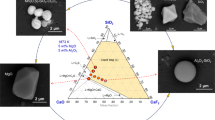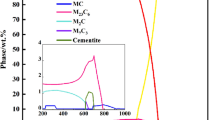Abstract
Physicochemical characteristics of the nitrogen-alloyed steel melt of the 04Kh20N6G11M2AFB grade (nitrogen content 0.47–0.49%) are investigated by using the torsional vibration method of a crucible with metal in the atmosphere, which provides a stable nitrogen content during the experiment (80% nitrogen and 20% helium). Using the method sensitivity to the aggregate state of the tested substance, at a heating rate of 0.0033–0.0050 K/s, the liquidus temperatures are experimentally determined for the 04Kh20N6G11M2AFB steel (1660–1666 K) and low nitrogen steel ([N] = 0.063%) with the identical content of other elements (1685–1690 K). These results make it possible to recommend the value of the coefficient –60 K/% [N] for the calculated assessment of nitrogen influence on the liquidus temperature of complex and high alloy steels. The viscosity of the 04Kh20N6G11M2AFB steel melt is relatively high ((11.5 ± 0.7) ×10–7 m2/s) in comparison with the traditional austenitic steels ((8.2 ± 0.2) × 10–7 m2/s) with a relatively small partial effect of nitrogen. A significant nonequilibrium of the structural state of the 04Kh20N6G11M2AFB steel melt is revealed by the high-temperature viscometry methods. The comparative analysis of polytherms and kinematic viscosity isotherms of the 04Kh20N6G11M2AFB steel melt and its low nitrogen ([N] = 0.063%) analogue makes it possible to conclude that the nitrogen presence in concentrations close to saturation plays a decisive role in the melt nonequilibrium level and low relaxation rate. This is confirmed by the results of special experiments on saturation with nitrogen of low nitrogen steel, in which a sharp increase in nonequilibrium of the melt structural state is recorded when nitrogen concentration in metal reaches the limiting values (0.45–0.50%). There is a potential possibility to increase and stabilize the operational properties of corrosion resistant nitrogen-alloyed steels due to reducing the melt’s structural state nonequilibrium by excluding the excess of limiting values of nitrogen concentrations for the chemical composition considered.




Similar content being viewed by others
REFERENCES
Shvidkovskii, E.G., Nekotorye voprosy vyazkosti rasplavlennykh metallov (Viscosity of Melted Metals), Moscow: Gostekhizdat, 1955.
Shpil’rain, E.E., Fomin, V.A., Skovorod’ko, S.N., et al., Issledovanie vyazkosti zhidkikh rasplavov (Investigation of Liquid Melts Viscosity), Moscow: Nauka, 1983.
Gorbach, V.D., Kuz’min, S.A., and Stetsukovskii, E.V., Possibility of using new high-nitrogen steel for the production of cast billets, Liteinoe Proizvod., 2009, no. 6, pp. 23–28.
Roeser, W.F. and Wensel, H.T., Freezing temperatures of high-purity iron and some steels, J. Res. Natl. Bur. Stand., 1941, vol. 26, pp. 273–287.
Lifshits, A.G. and Edneral, F.P., Influence of some alloying elements on the temperature of steel solidification beginning, Izv. Vyssh. Uchebn. Zaved., Chern. Metall., 1965, no. 9, pp. 74–79.
Basic Open Hearth Steelmaking, New York: Am. Inst. Min. Metall. Eng., 1951.
Smirnov, A.N., Nedel’kovich, L., Dzhurdzhevich, M., Chernobaeva, T.V., and Odanovich, Z., Calculation of liquidus temperature of steel, Stal’, 1996, no. 3, pp. 15–19.
Howe, A.A., Estimation of liquidus temperatures for steels, Ironmaking Steelmaking, 1988, vol. 16, no. 3, pp. 134–142.
Kazachkov, E.A. and Makurov, S.L., Experimental study of the thermophysical properties of steels in liquid, two-phase and solid state, in Issledovanie protsessov s uchastiem okisnykh i metallicheskikh rasplavov (Investigation of Processes Involving Oxide and Metallic Melts), Moscow: Metallurgiya, 1983, no. 148, pp. 120–127.
Wang, X., Wang, X., Wang, B., Wang, B., and Liu, Q., Differential calculation model for liquidus temperature of steel, Steel Res. Int., 2011, vol. 82, no. 3, pp. 164–168.
Kagawa, A. and Okamoto, T., Influence of alloying elements on temperature and composition for peritectic reaction in plain carbon steels, Mater. Sci. Technol., 1986, vol. 2, no. 10, pp. 997–1008.
Andrews, K.W., Solidification ranges of steel, in A Note Submitted to the Alloy Phase Diagram Date Committee of the Metals Society, London, 1981, pp. 1–8.
Klimov, S.V., Influence of nitrogen on a decrease in temperature of crystallization beginning of alloyed melts, in Proizvodstvo i svoistva stali i splavov (Production and Properties of Steel and Alloys), Moscow: Metallurgiya, 1968, no. 63, pp. 28–31.
Smirnov, L.A., Gorbachev, I.I., and Popov, V.V., Study of nitrogen solubility in austenitic steels during smelting and subsequent crystallization using CALPHAD, Vopr. Materialoved., 2018, no. 4 (96), pp. 53–67.
Doolittle, A.K., Studies in Newtonian flow. II. The dependence of the viscosity of liquids on free space, J. Appl. Phys., 1951, vol. 22, no. 12, pp. 1471–1475.
Bian, X., Sun, M., Xue, X., and Qin, X., Medium-range order and viscosity of molten Cu–23% Sn alloy, Mater. Lett., 2003, vol. 57, no. 13-14, pp. 2001–2006.
Cheng, S.-J., Bian, X.-F., Zhang, J.-X., et al., Correlation of viscosity and structural changes of indium melt, Mater. Lett., 2003, vol. 57, no. 26-27, pp. 4191–4195.
Zhao, X., Bian, X., Wang, C., and Li, Y., The evolution of coordination structure in liquid GaSn alloy, Chin. J. Phys., 2018, vol. 56, no. 6, pp. 2684–2688.
Burmasov, S.P., Gudov, A.G., Degai, A.S., Stepanov, A.I., and Smirnov, L.A., Formation of iron-based melts and scope for improvement in steel properties, Steel Transl., 2010, vol. 40, no. 8, pp. 741–745.
Zuev, M.V., Burmasov, S.P., Stepanov, A.I., Gudov, A.G., Murzin, A.V., and Zhitlukhin, E.G., Improvement in steel smelting by studying melt behavior, Steel Transl., 2013, vol. 43, no. 2, pp. 106–109.
Author information
Authors and Affiliations
Corresponding authors
Additional information
Translated by N. Semenova
About this article
Cite this article
Smirnov, L.A., Gudov, A.G., Burmasov, S.P. et al. The Physicochemical Characteristic Study of Melts of Corrosion Resistant Nitrogen-Alloyed Steels. Steel Transl. 50, 659–664 (2020). https://doi.org/10.3103/S0967091220100095
Received:
Revised:
Accepted:
Published:
Issue Date:
DOI: https://doi.org/10.3103/S0967091220100095




